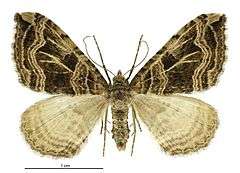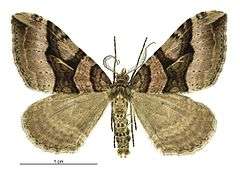Xanthorhoe semifissata
Xanthorhoe semifissata is a moth of the family Geometridae. It is native to New Zealand.
| Xanthorhoe semifissata | |
|---|---|
 | |
| Female | |
 | |
| Male | |
| Scientific classification | |
| Kingdom: | |
| Phylum: | |
| Subphylum: | |
| Class: | |
| Order: | |
| Family: | |
| Genus: | |
| Species: | X. semifissata |
| Binomial name | |
| Xanthorhoe semifissata Walker, 1862 | |
Description
A small to medium-sized moth with a wing span 25–35 mm.
Distribution and habitat
Is found in both the South and North Island of New Zealand.[1]
Has been collected occasionally in Riccarton Bush, Christchurch.[2]
- 1920–1945 Lindsay, Heighway and Tonnoir
- 1980–1988 Muir and Dugdale
The habitat/foodplant for this moth is herbaceous plants. Gaskin noted eggs are laid on watercress (Nasturtium officinale).[3] White [4] listed Cardamine and stream Nasturtium as known larval foods.
Life cycle
Eggs
Eggs are pale green and hemispherical in shape.[3]
Larva

The caterpillar is dark brown on its upper side and light brown below, When fully grown it is approximately 2.5 cm long.[3]
Adult
The adults have been collected in March, May, August and October in Riccarton Bush, Christchurch.[2] In montane grasslands at Cass, Arthurs Pass the moth was seen from November through to April.[4]
References
- White, E G (2002). New Zealand Tussock Grassland Moths. Lincoln, New Zealand: Manaaki Whenua Press. p. 291.
- Molloy, Brian (1995). Riccarton Bush: Putaringamotu. Christchurch: The Riccarton Bush Trust. p. 227.
- Gaskin, D E (1966). The Butterflies and Common Moths of New Zealand. Christchurch: Whitcombe and Tombs Limited. p. 134.
- White, E G (1991). "The changing abundance of moths in a tussock grassland, 1962–1989, and 50- to 70- year trends". New Zealand Journal of Ecology. 15 (1): 5–22.